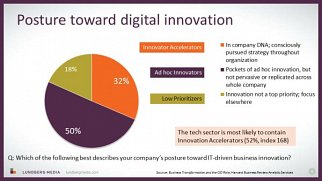Archive of: HBR Analytic Services
Blog Post

The landscape for performance management is changing dramatically. Business leaders know they can get more value using performance management as a tool to engage and develop people rather than to just assess them. However, while they recognize the link between employees’ level of engagement and their performance, most organizations still operate performance management and employee engagement on separate tracks, according to this recent research report I wrote for Harvard Business Review Analytic Services.
Blog Post

I have to admit it — I'm baffled. In all the research I've done in the past year, business leaders again and again say they believe the CIO is the right person to lead digital innovation. And yet, again and again, there's a gap between where everyone — CIOs and their business partners included — think the CIO should be and where they actually are. CIOs just can't seem to break out of the technology service provider role.
In the Harvard Business Review Analytic Services study, "Business Transformation and the CIO Role," 94% of respondents said CIOs would add the most value to the business by either leading business technology transformation or, even better, leading IT-driven business innovation and strategy. Only 6% voted for the CIO to focus on running the IT function to support business operations. And yet the vast majority — 70% — said that's exactly where the CIO spends his or her time.
I've also had a number of conversations lately with strategic CIOs who view their role as helping their business leverage information — they frame the digital opportunity in that context. Sure, they need technology to do that, but that's not where the value lies or how they define their role.
Blog Post

Back in the 1990s and into the early part of the 2000s, we ran an awards program at CIO magazine called the Enterprise Value Awards. This was a unique and truly outstanding awards program that scrutinized the work being done by CIOs and their business partners — and the results being delivered — through the use of information technology. Every nomination had to have a CIO and a business leader as joint sponsors. They had to prove claimed financial value by having the company's CFO sign off on the numbers. Every finalist received a site visit from an experienced reviewer who met in person with company leaders and users of the system to vet the claims being made. These review board members then presented their findings to a blue-ribbon panel of CIOs at a day-long meeting in Boston. The winners were recognized at an annual Enterprise Value Retreat.
Blog Post

I just had my first highlights reel made and I'm pretty excited. I delivered the opening keynote at the Oracle Cloud World conference in Boston in December 2014. Oracle did a great job filming it in the first place, and my friend the very talented videographer Craig Kimberley at Skyprop Media did a great job editing it down to a couple of minutes. This shows both my onstage work and the kinds of (very visual) slides that I create. I hope you like it!
Blog Post

Creating the conditions for and harnessing innovation isn't easy, especially for large organizations. Innovation Accelerators — companies that are committed to innovation across the enterprise — take a managed, structured approach. That may seem contradictory — after all, isn't innovation supposed to be creative and spontaneous? Creative, yes, but if you rely on spontaneous combustion to light your innovation process, your results will be uneven at best.
Blog Post

One of the most interesting research projects I've worked on in the past year was an HBR Analytics Services study sponsored by Red Hat as part of their Enterprisers Project. In it, we divided the universe based on respondents' posture toward IT-driven business innovation — for simplicity's sake, let's call it digital innovation. There were three categories:
Innovation Accelerators: These respondents said that digital innovation is a consciously pursued strategy throughout the organization — it's in their company's DNA.
Ad Hoc Innovators: These companies have pockets of digital innovation, but it is not pervasive or replicated across the whole company.
Low Prioritizers: At these firms, digital innovation is not a priority; they focus elsewhere.
Blog Post

I've saved the best for last in this series of posts on responsive IT. In our survey of 750 business and technology leaders (around 200 from IT and the remaining 550 from other parts of the business), 42% of respondents believe the CIO is the best suited member of the C-suite to lead digital transformation. (Yes, I know this term has become overused, but this is what we're talking about, so I'll learn to live with the shame.) That's more than twice as many as chose the CEO (18%). And that number shot up to 64% when we singled out the IT respondents. This is great news for CIOs, right?
Yes, but... when we look at the responses of general managers, things are less clearly defined. While CIOs still lead at 30%, there are also strong votes for the CEO (21%), LOB leader (17%), and COO (15%). This makes sense. As digital business becomes more pervasive, it is absolutely incumbent upon non-IT leaders to understand the opportunities and threats digital represents and to do everything in their power to drive their organization's ability to compete. Some of them are becoming quite astute in this regard. It's also true that even if the CIO is responsible on a day-to-day basis to lead this transformation, not much will happen without a clearly articulated vision from the CEO.
Blog Post

IT has become integral to many aspects of business, from marketing and customer engagement to new product design. This requires a new way of organizing and engaging across functions.
How important is this cross-functional engagement? It's huge. Seventy-five percent of the 750 respondents to our global survey (see “The Leadership Edge in Digital Transformation," from HBR Analytic Services) say that their company's survival depends on their ability to effectively exploit IT, and almost all — 90% — said that collaboration and communication between IT and other stakeholders in the business is essential to their ability to do so.
Blog Post

In a digital age, business survival depends on responsive IT. That is one of three key findings from a recent global survey of 750 business and technology leaders that I led for HBR Analytic Services ("The Leadership Edge in Digital Transformation"). Almost half of respondents (47%) said their organization had missed opportunities because IT was too slow to respond. While it's reasonable to expect some misses, companies with slow-to-respond IT departments were much more likely to say this at 64% than were respondents from companies with responsive IT (only 27% said they'd missed opportunities).
Companies with highly responsive IT (let's just call them the "Leaders" for brevity's sake) have gone faster and farther in making the transition to digital business than their competitors. This proved to be the case across many dimensions, starting with the ways in which they engage with customers: 68% of the Leaders said their customer engagement had been transformed by their use of new technologies compared with only 33% of Laggards. The delta was even greater when it came to business model transformation, with 62% of Leaders transformed compared with only 24% of Laggards. This translates directly to competitive advantage.



